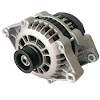Main Controls in thermal power plant
Until few years back, even in case of large power plants the various controls are used to be done manually on the basis of instrument readings. However, now a days the various controls involved in the power plant operation have been completely automated resulting in
1. Increase Labour productivity
2. Increase in operation with more reliable and safely.
3. Repairing time is increased.
In thermal
power plants the boilers, turbine and generator unit are provided with Automatical
controls for maintaining continuous operations at all loads.
Automatic Control of boiler
By means of
automatic combustion control it because easy to maintain constant steam
pressure and uniform furnace draught and supplying the air (or) fuel can be
regulated to meet the changes in steam demand. The boiler operation because
more flexible and better efficiency of combustion is achieved. It also saves
manual labour.
Hagan system
of automatic combustion control is shown in fig. Master relay R1, is sensitive
for small variations in steam pressure which is connected to steam pressure
gauge.
A fall in
pressure operates the master relay R1 which in turn operates the servo motor
coupled to the vanes of the induced draught (LD) fan to open them slightly and
simultaneously the takes place and stabilized conditions in the combustion
chamber get changed. These changes operate relay R2 to alter the position of
forced draught fan servo-motor to adjust the position this change causes more
air to flow through passage which in turn operates R3. This causes stoker motor
to supply extra fuel into the furnace. Increase of an increase of pressure of
steam the above process is reversed.
Control of turbine
Turbine
governing is affected by throttling the steam at the main value (Thus reducing
the steam pressure and hence mass flow also) or by reducing only the steam mass
flow by cutting off one or more nozzles through which the steam enters the
blades. The first method of governing know as throttle governing or qualitative
governing, is used in case of small turbines and the second method of
governing, know as nozzle governing or cut off governing or quantitative
governing, is used for large turbines. Maintenance of proper vaccum in the
condenser, enough circulating water, a number of pumps, oil pressure for
control of circuits, steam bleeding if any and the heater and feed water
control are other requirements for the turbine.
Control of
generator (or) Alternator Unit
In case of an isolated generating unit, increase in load causes reduction in the speed of the unit and hence reduction in frequency remains constant.
In general, centralized control is employed for modern steam power plants, the boiler and turbine control being at one place in the turbine room and the generator and feeder controls in the controls room, in some case all controls are centralized in one room, called the control room.
Control of condensers
The performance of a condenser is mainly depends on the control of following:
1. The air leakages at the joints, packing’s and glands of the condenser. This amount of air leakages can be controlled by improving the performance of workmanship.
2. The feed water contains air in dissolved condition. The dissolved air gets liberated when the steam is formed and it is carried with the steam in to the condenser.
The air from
the condenser is removed with the help of air pumps.










0 Comments